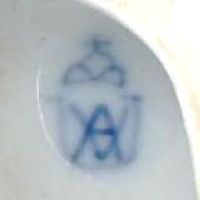
Image 011246-03-01
Used between late 1899 and 1909, one of the first Aelteste Volkstedter Pozellanmanufaktur, Unterweißbach marks.
(Picture: Janny Könsgen)
In 1882 Hermann Jost founded the porcelain Porzellanfabrik Unterweißbach. First, only plates and kitchenware were produced. A constant rise in quality was achieved as more and more skilled workers were employed and so the range of products was also growing. During 1890 the company was bought by Rudolf Mann for 30,000 Marks and two years later businessman Fritz Porzelius joined the company as associate.
During the next few years the company had a strong economic upturn and in 1899 the company was changed into a joint-stock company, resulting in the name change including the addition AG for Aktiengesellschaft.
The names used during this time can be pretty confusing. Officially it was the Porzellanfabrik Unterweißbach AG, but it sometimes appears with an addition like vormals Mann & Porzelius in advertisements or letter heads, a completely legit way of using the reputation created by the former proprietors for marketing purposes. Shortly after the company was changed into a stock corporation it confusingly also merged with the Aelteste Volkstedter factory from Volkstedt and the name for this group was the infamously long and confusing Aelteste Volkstedter Porzellanmanufaktur und Porzellanfabrik Unterweißbach vormals Mann & Porzelius AG, the longest German company name I have met so far.
In 1908 Max Adolf Pfeiffer integrated his Schwarzburger Werkstätten für Porzellankunst into the corporation as a stand-alone department using own marks (for example the 'running fox'). As member of the Deutscher Werkbund, a group believing in a thesis of aesthetic modernization through a combination of craftsmen and industrial production, Pfeiffer united both artistic and manufacturing parties. A year later Pfeiffer fully realized the project as a part of the proposed reforms in the educational and applied arts. This idea resulted in cooperations with many famous artists of that time including Ernst Barlach, Max Esser, Paul Scheurich, Gerhard Marcks and Etha Richter.
During the last years, more and more porcelain manufacturers had opened in the area. Companies went through takeovers and alliances to survive and so during 1909, the Aelteste Volkstedter Porzellanmanufaktur in Volkstedt and the former Mann & Porzelius AG which in the meantime was only named Porzellanfabrik Unterweißbach, formed a union. A quite interesting fact is that the Aelteste from 1899 onwards had been a joint-stock company for only two years when the Unterweißbach Mann und Porzelius AG, which was also transformed into a joint-stock company the same year became major share holder.
Some sources even indicate that the Aelteste already was bankrupt in 1901 and had been taken over by Mann & Porzelius, but was run as an independent branch until 1909. This is not mentioned in an original booklet from the Aelteste, but can be found in an original booklet from Unterweissbach. In 1910 the main office of the Unterweißbach factory was moved to Volkstedt and the name was changed to Aelteste Volkstedter Porzellanmanufaktur und Porzellanfabrik Unterweißbach vormals Mann und Porzelius AG.
In 1910 the Unterweissbach factory received a gold medal at the Brussels World Exposition and a silver medal at the International Hunting Exhibition in Vienna, followed by medals and prizes awarded at the Turin exhibition in 1911 and the year 1913 brought them gold medals in Leipzig and Geneva. During 1913, Max Adolf Pfeiffer also retired as manager of the Schwarzburger Werkstätten and joined the porcelain factory in Meissen. The year 1915 saw the company receive another medal at the Baltic Exhibition. This very lucrative phase was based mostly on the work of Doctor Edmund Troester, the Director of the Aelteste Volkstedter Porzellanmanufaktur between 1908 and 1931.
But history had a bad surprise up its sleeve. As a consequence of the World Financial Crisis (from 1929 until around 1933) the company had to file for bankruptcy and the 'Porzellanfabrik Unterweißbach' was split out of the assets and the Aelteste continued business as Staatliche Porzellanmanufaktur Thüringen.
Karl Saar owned the factory from 1936 onwards, but he already passed away in 1940; the factory was quickly taken over by Heinz Schaubach, who already owned the well-known factory in Wallendorf.
Schaubach decided to completely restructure the business and brought the workforce down to a mere 40 people. At the same time, he sold a few factory buildings and thus secured enough money for his next step. He then changed the product range, abandoning the simple mass-produced models and re-introducing the much more demanding artistic work. These measures were very successful, resulting in an economic upturn. In 1953 the factory not only had a very good reputation again, it was also back to a workforce of 160 people.
On March 5th 1953 the company was nationalized and during 1970, it was integrated into the VEB Vereinigte Zierporzellanwerke Lichte combine. This allowed the Unterweißbacher factory to re-adjust its profile and continue with more traditional designs, resulting in motifs like pompous coaches of state or groups of people, both showing scenes from the 'Grand Siecle' period in finest detail. Hunting scenes or seasonal motifs were also part of the unmistakable reportoire that was always determined by excellent craftsmanship. Highly acclaimed artists like Kurt Steiner, a former teacher at the prestigious drawing school in Lichte, created chess pieces and groups of musicians or harlequins. Gustav Oppel, known for his fantastic modelling skills or Heinz Schober and his wonderful artistic interpretation of hunting scenes - they all added to the wonderful pieces that made the Unterweißbacher Werkstätten unforgettable.
After German reunification in 1990 the factory at first contiunued production on its own, soon catching the interest of the Königlich privilegierte Porzellanfabrik Tettau GmbH factory and its financial backers. These soon decided to acquire the factory and let it continue operations under its old name. With date of August 29th 2006 (publication date: September 11th 2006) the Unterweißbach factory fully merged into the Porzellanfabrik Tettau GmbH and was on November 8th 2006 officially deleted from the trade register.
A manufacturer-verified fact is that no evidence on marked Herman Jost or Mann & Porzelius products exists and nobody can tell if they were marked at all; it is a pity that references like the flaw-infested books by Robert Röntgen incorrectly claim the opposite and are then copied by other self-proclaimed "experts" (Kovels's, etc.) that have no idea themselves and do not care to verify the given info.
The stylized "AVP" in an "U" was a development out of the "AeV" mark used from 1899 by the Aelteste Volkstedter after they became a limited company. It stands for Aelteste Volkstedter Porzellanmanufaktur, Unterweißbach. In general the marks of the Schwarzburger Werkstätten für Porzellankunst were accompanied by an impressed "U" for Unterweißbach.

Image 011246-03-01
Used between late 1899 and 1909, one of the first Aelteste Volkstedter Pozellanmanufaktur, Unterweißbach marks.
(Picture: Janny Könsgen)
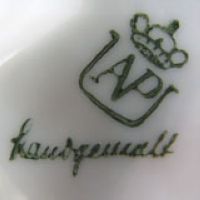
Image 011246-03-02
Used between late 1899 and 1909, a stylized "AVP" in an "U".
(Picture: Nora McClurg)
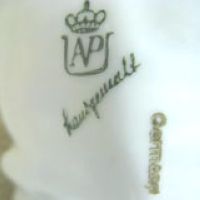
Image 011246-03-03
Same as before but with both a handgemalt and "Germany" addition.
(Picture: Nora McClurg)
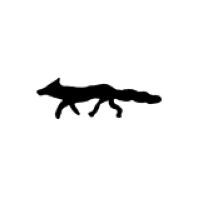
Image 011246-03/04-01
Used between 1909 and 1925, a blue or impressed running fox combined with impressed "Schwarzburger Werkstätten für Porzellankunst".
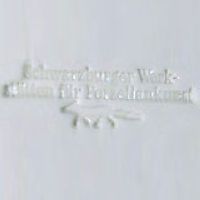
Image 011246-03/04-01
Used between 1909 and 1925, example of the impressed running fox combined with impressed "Schwarzburger Werkstätten für Porzellankunst".
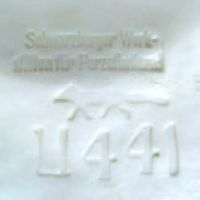
Image 011246-03/04-01
Here is another perfect example of both impressed elements accompanied by an impressed "U" for Unterweißbach postitioned before the item number.
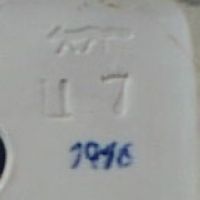
Image 011246-03/04-01
Another example of the fox, no other marking except the added date "1916" in blue.
(Picture: Steve Swan)
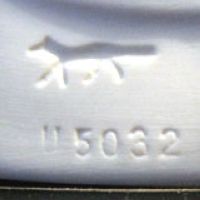
Image 011246-06-01
Take note that this version is different: a nice running fox with the "U" for Unterweissbach but ...
(Picture: Kim Cooper)
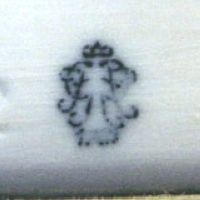
Image 011246-06-02
... in this case marked by the Aelteste Volkstedter factory in Volkstedt (here a mark version used after 1945).
(Picture: Kim Cooper)
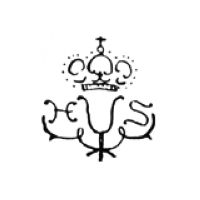
Image 011246-06/07-01
Used between 1940 and 1958, the initials "HS" flanking an "U" stand for Heinz Schaubach, Unterweißbach.
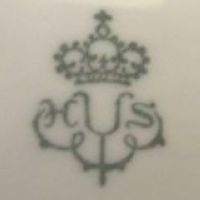
Image 011246-06/07-02
Used between 1940 and 1958, here an example in green.
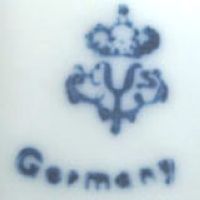
Image 011246-06/07-03
Used between 1956 and 1962, actually same as before only with "Germany" addition.
(Picture: Murray Dales)
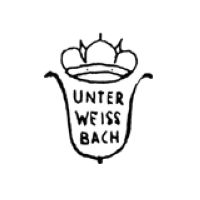
Image 011246-07-01
Used after 1953 and parallel to the previous marks, here an early version without included VEB.
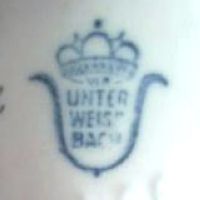
Image 011246-07-02
Used between 1958 and 1976. Final version, note the small "VEB" in the crown.
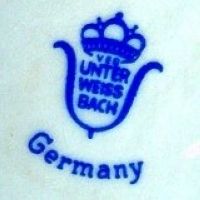
Image 011246-07-03
Used between 1958 and 1976. Small "VEB" in the crown and generic "Germany" addition.
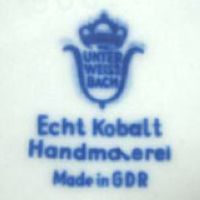
Image 011246-07-05
Used between 1958 and 1976. Here with "Echt Kobalt", Handmalerei and "Made in GDR" additions.
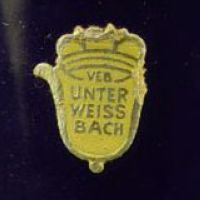
Image 011246-07-06
Sticker used between 1970 and 1976. These were rare, also note the letters VEB above "Unterweissbach".
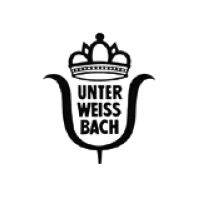
Image 011246-07-07
Used between 1977 and 1985, note the missing "VEB" in the crown.
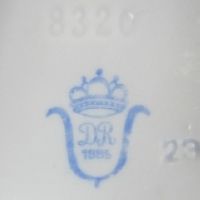
Image 011246-07-08
During the 1980s the company sold undecorated seconds to studios and this is one of the resulting marks.
(Picture: Jean Revell)
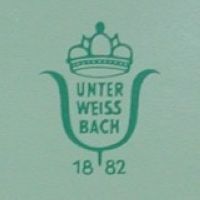
Image 011246-07-09
Used between 1986 and 1990, note the included small founding year of "1882".
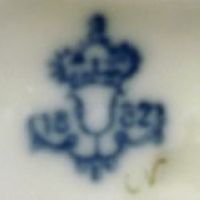
Image 011246-08-01
Used since 1990, similar to the 1940s/1950s marks but with "1882" instead of "HS" flanking the "U".
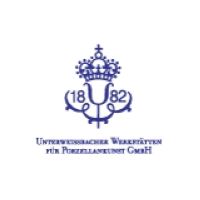
Image 011246-08-02
Logo of the Unterweißbacher Werkstätten für Porzellankunst GmbH, used since 1990.
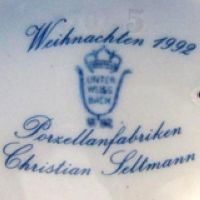
Image 011246-08-03
After the takeover by the Porzellanfabrik Tettau (owned by Seltmann) the factory used combo marks on special editions, here Christmas 1992.
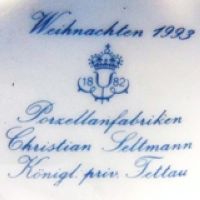
Image 011246-08-04
After the takeover by the Porzellanfabrik Tettau (owned by Seltmann) the factory used combo marks on special editions, here Christmas 1993.
© 2004-2025 C.S.Marshall, all rights reserved